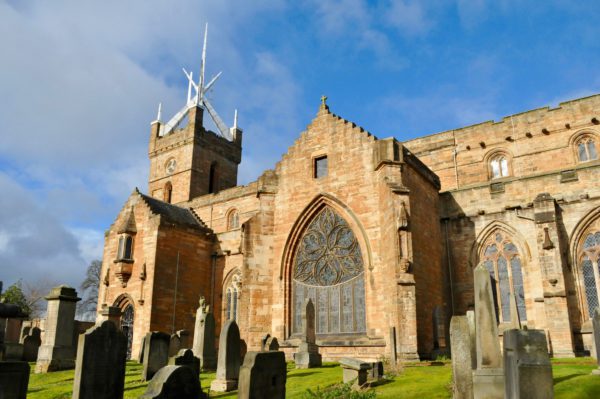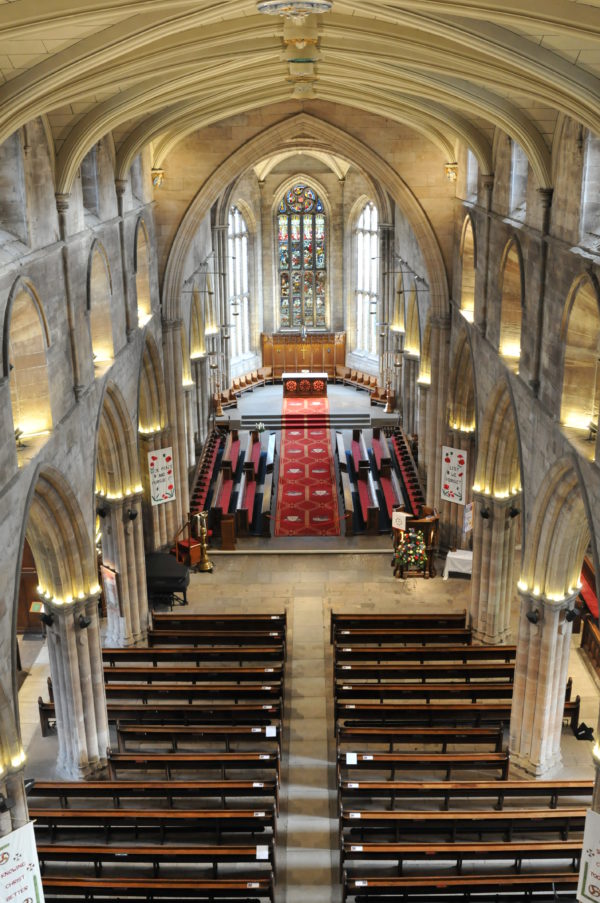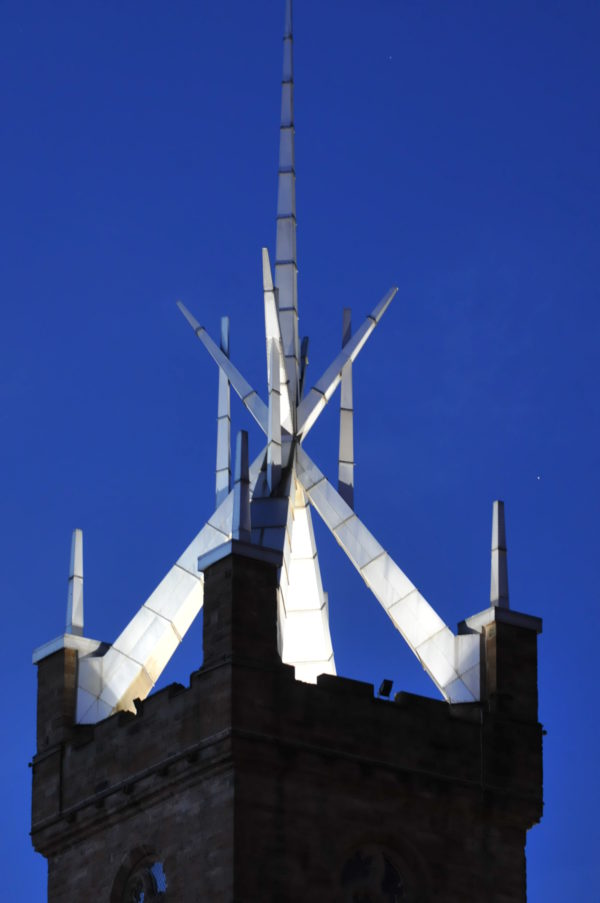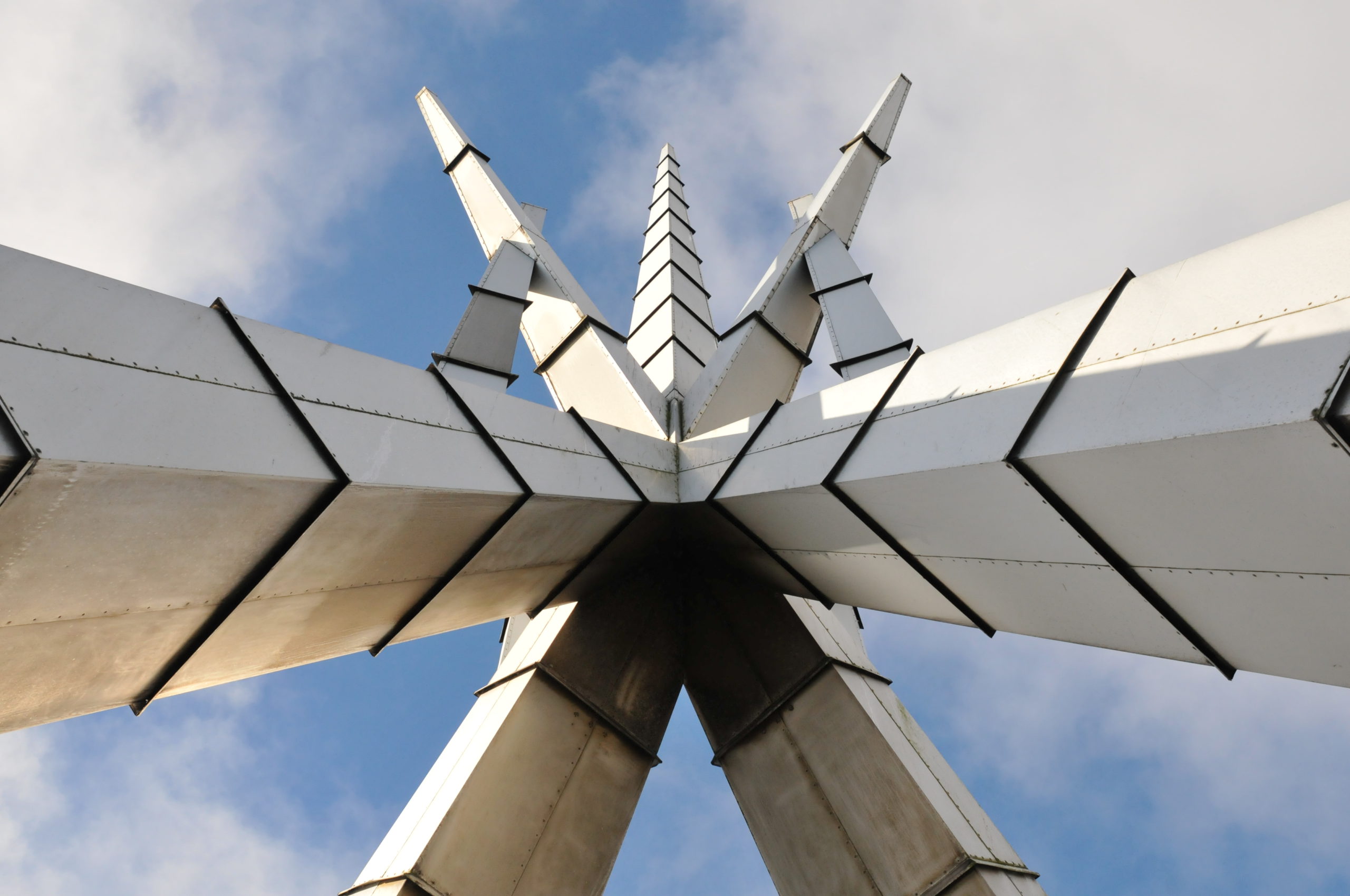By: Judy Vickers
When the spire on Linlithgow’s parish church was first erected in 1964, its modern shiny look, contrasting so sharply with the weathered stone of the ancient building, sparked a fierce reaction. Some said it looked like a rocket waiting to take off, others compared it to a wigwam. Certainly many felt the contemporary aluminium “crown of thorns” did not belong on a medieval church just a stone’s throw from the birthplace of Mary, Queen of Scots. But it was the vision of the then minister, the Very Rev Dr David Steel, father of the politician Lord Steel, to create something bold and iconic. “And the way people have reacted over the years, I think he really achieved that,” says Alan Miller, an elder at the church, St Michael’s.
Emblem for the town

Because the spire, representing the crown of thorns forced on Christ’s head before he was crucified, with 12 smaller spikes for the 12 apostles, has become a real emblem for the town, appearing on many local businesses and organisations’ logos, and on images of the former Royal Burgh. As it approaches its 60th anniversary, however, the spire is in difficulties – the campaign Alan is referring to, Aspire Linlithgow, is aiming to raise £300,000 to save the crown. The timber structure under the aluminium cladding is badly rotted and needs urgent work if it is to remain in place. If the fundraising campaign is successful, the restoration will see the spire re-clad in a bronze alloy, giving it a pale gold look instead of its current silver – which will actually be a return to its original tone. “The pale gold basically weathered away after a few years. The new cladding will be a bronze alloy and it will stay pale gold. It will look magnificent,” says Alan, who is head of the fundraising campaign.

It will be the latest chapter for the church which has seen centuries of Scottish history, much at first hand. St Michael’s has stood witness to the ravages of the Scottish Wars of Independence and Oliver Cromwell’s invasion, hosted royalty, to the violence of 16th century protestant reforms, provided a refuge from the plague in the 17th century and withstood the body-snatchers of the 19th century. Its first appearance in history books is in 1138 when it was described as “the great church of Linlithgow” in a charter of King David I, gifting it to the Cathedral of St Andrews, although historians believe it dates back to well before that. Edward I, the King of England and so-called Hammer of the Scots, requisitioned the church as a storehouse in 1301 as the First Scottish War of Independence raged with the English monarch attempted to control his northern neighbour.
Bannockburn brought peace and the chance to repair the church after the destruction of the war, but in 1424 a massive fire badly damaged both the church and the adjacent royal palace. Rebuilding work took 115 years, with money coming from the Stewart kings and fines for chimney fires – Linlithgow Palace was also rebuilt during this period, becoming a holiday retreat for the Stewart kings, who used the church to worship in between jaunts out hunting in the surrounding pleasure park.
In 1513, King James IV was one of those monarchs but when he stepped inside St Michael’s he was confronted by a spirit, an old man in a cloak, who warned him not to go to war with the English – he ignored the spirit’s words of caution and died at the Battle of Flodden. By the 1540s, St Michael’s was restored to glory, with 20 stone carved saints in niches around the outside of the church and a stone “crown”, similar to the one which still stands at Giles’ Cathedral in Edinburgh, topping the square tower. It was ready in time for the baptism of Mary, Queen of Scots, who was born at the palace in December 1542. But Mary’s reign was marked by bitter battles between those of her religion, Roman Catholicism, and the growing Protestantism and St Michael’s did not escape. In 1559, the font used to baptise Mary, along with statues and altars deemed to be too “popish” for the new religion were smashed.
Golden glory

The 17th century was no kinder – it was briefly used by the University of Edinburgh in 1645 when plague in Edinburgh saw scholars flee the city, then shortly after came perhaps its darkest moment when Oliver Cromwell, the leader of the republican regime in Britain, requisitioned the church and used it to stable his horses and to billet his troops. Another restoration to repair Cromwell’s damage followed but by the 19th century the church was in a poor state, with whitewashed walls, and the 16th century ceiling replaced with a plaster one. A watchman’s hut was erected outside with three men keeping guard at night to prevent body-snatchers digging up and selling recent corpses to the medical schools in Edinburgh – grieving families could also hire a metal cage to be fixed over newly-dug graves. And in 1821, the stone crown was removed after it was discovered it was too heavy for the tower and was in danger of collapse. The tower stayed bare until the 1960s. “I suppose the only option in the 1820s would have been some other stone structure and that wasn’t possible as the tower was in a poor state and had to be stabilised.”
With conflicts on home soil, plague and graverobbers consigned to history, from the end of the 19th century onwards the church saw happier times, with a major restoration in the 1890s reviving much of its ancient glory. Churches are almost always in need of repair, though, and it was due to a fundraising campaign for essential maintenance in the 1960s that the idea of the spire came about. “David Steel always had the idea that if there was money left he would like to create something on the top of the tower,” says Alan.“Geoffrey Clarke came up and looked at the church, three months later he sent a box containing a small model of the spire. One local architect who saw it said: ‘That’s genius!’” Today as well as welcoming many tourists, St Michael’s is still a vibrant place of worship and continues to evolve – one of its more recent innovations came in 1992 with the installation of a new stained glass window in the St Katherine’s aisle, around the theme of Pentecost, which dapples the church floor with multi-coloured light.

And now the next stage of the church’s evolution is in motion. The Aspire campaign has already had £120,000 pledged and Alan hopes it won’t be long before work can begin on restoring the spire to it golden glory. “The fact that so many people have donated to our campaign shows it is a unique and iconic piece of work that people are proud of,” he says.
For more information on the campaign, visit: www.stewardship.org.uk/pages/aspirelinlithgow

